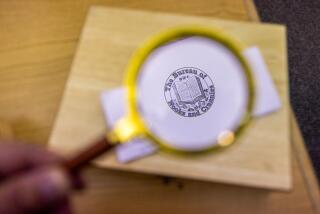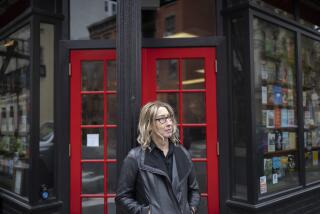Morgan Library Spreads Its Wings: Recent expansion has created new interest in bankerâs impressive collection of rare books.
NEW YORK â When J.P. Morgan died in 1913, he left a fortune of $68 million. âAnd to think,â John D. Rockefeller remarked, âI always thought he was rich.â
The nationâs greatest banker was evidently better at spending money than at saving it, and his ultimate legacy was a collection representing 12 centuries of European art. Morganâs paintings and objets dâart were divided between New Yorkâs Metropolitan Museum of Art and the Wadsworth Atheneum in Hartford, Conn.
Only the books and manuscripts stayed home, in J. Pierpont Morganâs own private library, which had been built in 1906 next door to his mansion on Madison Avenue in Manhattan. Four years after opening to the public in 1924, the library expanded over the site of J. P.âs mansion, at the corner of Madison and 36th Street. Last fall, the library finally settled the block and its own future when it expanded all the way to the 1852 mansion on the next corner--Madison and 37th--a home that once belonged to J.P. Morgan Jr.
âA lot more active in here than it used to be, huh?â a librarian said to a guard right after the grand reopening Oct. 1. And that is just the case: A new drive seems to have embraced the genteel old library. Scholars, tourists and East Side neighbors have been stopping by in a steady stream âjust to see what all the excitement is about,â as one dapper man told the receptionist .
The excitement bubbles up from the libraryâs holdings as much as its new spaces. With another half-block, it now has the luxury of maintaining a permanent display of selections from the collection.
In the area of rare books and original manuscripts, the only American institution comparable to the Morgan is the Huntington Library in San Marino. J. P. Morgan and Henry Huntington were competitors in acquiring the worldâs treasured books--and as competitors, they held influence over each other in both little ways and big. Morgan built a private library; Huntington saw it: Huntington built a private library.
And while Huntington obtained one of the 48 known Gutenberg Bibles, J.P. Morgan bought three. Produced in about 1455 on the first press to use movable type, the Gutenberg Bible on display at the Morgan features print that is blindingly neat, even and straight. In their day, Gutenbergâs Bibles represented the outer edge of technology, mitigated only by the hand-drawn decorations in the margins: homey beauty calling out to the machine-made perfection around it.
Before Gutenbergâs Bibles , the finest books were printed and decorated by hand, page by page. The Morgan houses several hundred such works, known as âilluminated manuscripts.â Many are religious in subject, but not all: One on view recently depicted a medieval burglary.
The collection of authorâs manuscripts covers final drafts from John Miltonâs âParadise Lostâ (1665)--which he dictated, having lost his sight--through the typescript for 1991 Nobel Prize winner Nadine Gordimerâs âSomething out There.â In Jane Austenâs neat hand in the manuscript of âLady Susanâ (1805) or Honore de Balzacâs maniacal corrections to just about every word of âEugenie Grandetâ (1833), an author is closely observed in these working copies.
So are composers. The Morgan Library has examples of Mozartâs hurried handwriting on the musical scoring for a 1786 rondo; Chopinâs tiny notations on an 1842 work, and Bachâs deliberate, dark blots for a cantata composed in 1731, among many other musical documents.
Earlier this year, the library staged a major exhibition of childrenâs books, and its own holdings in this genre are charming. Included is a copy of the first childrenâs book ever published, âLes Contenances de la Table,â a book of manners for good little French girls and boys of 1487.
The Morgan will continue to feature pieces from its own collections of books, manuscripts and drawings, in addition to exhibitions coordinated with other institutions. The major shows this year will celebrate 17th-Century Dutch drawings (through April 22); British landscape drawing, 1750-1850 (May 5 to Aug. 2), and Fra Bartolommeo (Sept. 11 to Nov. 29).
Even without the treasures of art and thought, emptied of books and sketches, the Morgan Library stands out. The original private library building is an axis, around which New York City has turned, writhed, surged and changed for 85 years.
When J.P. Morgan first moved into the neighborhood in 1865, Madison Avenue stopped at 40th Street, with farms beyond. When he decided to build his private library in 1900 in the side lot on 36th Street, he retained the services of the cityâs leading architect, Charles McKim. Now a landmark, the library is heavy in white marble and low among the skyscrapers that have replaced the farms.
This rather small library building is the anchor of the modern Pierpont Morgan Library compound. Inside are just two rooms, divided by a rotunda in cream mosaic. To one side is the East Room, lined on all sides with leaded-glass bookcases three tiers high. The only gaps make room for a 16th-Century tapestry and an elaborate fireplace.
The other room, the West Room, was Morganâs office, and it is simpler--only one tier of bookcases. Both rooms are sumptuous and serious, with an air of work to be done.
When America was gripped by a panic in October of 1907, bank presidents by the dozen filed into J.P. Morganâs library, hoping that he would save the day--or at least their own banks. Throughout the tense days and nights of the panic, Morgan spent most of his time in his library, playing solitaire, listening to deals and staking his fortune to save bank after bank.
On one of the first nights, Morgan locked a horde of bankers in the library with him and waited for them to agree to terms. Upton Sinclair and other journalists of the day accused Morgan of starting the panic, but most historians agree that he had persevered in stopping it, saving the country from a depression.
The thriving Morgan Library is a landmark of great ideas, while the West Room is a frozen monument to sheer power. In both, the presence of J.P. Morgan lingers.
More to Read
Sign up for our Book Club newsletter
Get the latest news, events and more from the Los Angeles Times Book Club, and help us get L.A. reading and talking.
You may occasionally receive promotional content from the Los Angeles Times.









